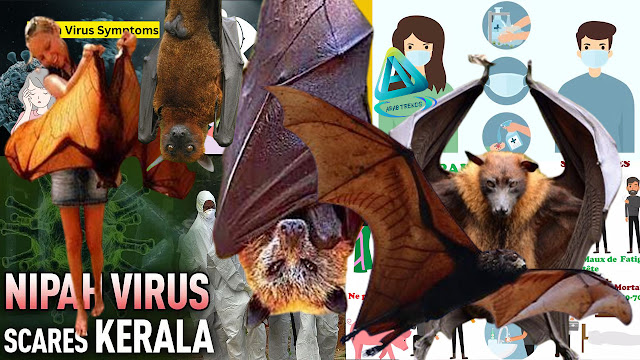With the re-emergence of the new Nipah virus, in India, studies and research conducted revealed that flying fox bats are the main cause and carrier of the deadly virus, according to the World Health Organization and the US Centers for Disease Control and Prevention
The world is living in a state of anticipation and follow-up as the engineering authorities deal with the new Nipah virus, and are trying to control it within certain states, and imposing isolation on several villages and stopping work in several companies, schools, and sectors, in an attempt to besiege the source of the virus, and conduct an examination of all suspected cases, following the death of cases. As a result of infection with the virus.
Nipah virus Flying fox batsz
In the report, we review the 10 most important pieces of information about flying fox bats and the cause of the new Nipah virus:
The giant golden-crowned flying fox bat, or the golden-domed bat, is one of the largest species of bats in the world.
Flying foxes travel around countries at a distance of up to 7 thousand kilometers per year.
The flying fox bat’s wingspan reaches 170 cm, it weighs 1.5 kg, and its body length does not exceed 30 cm.
Fruit bats, such as flying foxes, are the largest carriers of viruses in the world.
Flying foxes are considered reservoirs of rare, deadly diseases and deadly viruses.
Flying fox bats have been described as living in eternal conflict with humans and causing them many viruses and diseases.
Flying foxes help transport pollen in forests, but they also facilitate the transmission of diseases, to other animals and humans as well.
Flying fox bats have long lives and low reproductive frequencies, with females of most species producing only one offspring per year.
The life history of the slow flying fox bat makes them vulnerable to threats and extinction.
This type of bat is called the flying fox because its heads resemble the heads of small foxes.
The dark brown body of the flying fox bat is covered with a black head and a golden cap, while its back is dark pink.
Flying fox bats are threatened with extinction due to the loss of their habitats, hunting them as a food source, and due to deforestation and hunting.
The flying fox bat belongs to the family of giant bats (megabats) that live in various regions of Africa, India, Asia, and Oceania.
Flying foxes do not travel by echolocation, but rather rely on the senses of sight and smell.
The flying fox bat feeds on fruits, as figs are its favorite fruit, although it feeds on some other plant leaves.
These bats make loud noises when they feed on figs, mangoes, bananas, and flower nectar at dusk.
These bats feed at night, while they gather to sleep in large groups hanging from trees during the day.
The birth season for flying fox bats extends from April to June, and they give birth to one bat at a time.
Young bats cannot fly until they reach 3 months, which means that their mothers carry them when they fly until they reach this age.
These bats live in groups of up to a thousand bats, and because of the heat of their habitats and the fact that they have fur covering their bodies, they move their wings constantly.
The flying fox's skull consists of 24 bones, and like all mammals, flying foxes have three bones in the middle ear, which help transmit sound to the brain.
Flying fox skulls continue to develop after their birth, and the teeth consist of a total of 20 teeth. By 140 days, all the milk teeth or temporary teeth fall out and are replaced by permanent teeth, and the total number of teeth becomes 34 teeth.
















